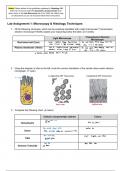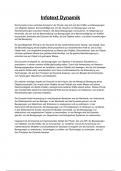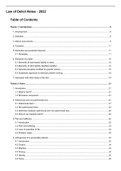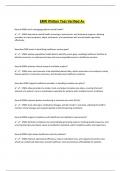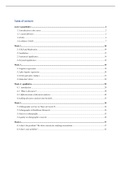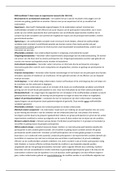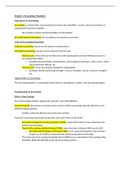Module 4: Mental Healthcare and Research
The Empirical Status of Empirically
Supported Psychotherapies
Critical view of the assumptions and studies – which were used to establish psychotherapies
as empirically supported
The attempt to identify empirically supported therapied (ESTs) – imposes assumptions on the
use of RCT methodology that appear to be valid for some disorders and treatments – e.g.,
exposure-based treatments of specific anxiety symptoms
- But substantially violated for others
Meta-analytic studies – support a more nuanced view of treatment efficacy than implied by a
dichotomous judgement of supported vs unsupported
Changes are recommended in:
1) Reporting practices – to maximize the clinical utility of RCTs
2) Describing alternative methodologies – that may be useful when the assumptions
underlying EST methodology are violated
Suggest a shift from validating treatment packages – to testing intervention strategies and
theories of change – that clinicians can integrate into empirically informed therapies
Retelling the Story – The Assumptions Underlying ESTs
Since the time ESTs came about – many advocates of ESTs have argued that clinicians
should be trained primarily in these methods – and that other forms of treatment are “less
essential and outdated”
ESTs and the research methods used to validate them – share a number of characteristics:
1) Treatments are typically designed for a single Axis I disorder
, - Patients are screened to (1) maximize homogeneity of diagnosis and (2)
minimize co-occurring conditions – that could increase variability of treatment
response
2) Treatments are manualized – and of brief and fixed duration – to minimize within-
group variability
3) Outcome assessment focuses primarily on the symptom that is the focus of the study
These characteristics make scientific sense – aimed at maximizing the internal validity of the
study
A valid experiment is one in which:
1. The experimenter randomly assigns patients
2. Manipulates a small set of variables
3. Controls potentially confounding variables
4. Standardizes procedures as much as possible
5. Is able to draw relatively unambiguous conclusions about cause and effect
The extent to which the use of RCT methodologies to validate ESTs – requires a set of
additional assumptions that are themselves neither (1) validated nor (2) broadly applicable
to most disorders and treatments
Not adequately investigated are the assumptions – that:
1) Psychopathology is highly malleable
2) Most patients can be treated for a single problem or disorder
3) Psychiatric disorders can be treated independently of personality factors unlikely to
change in brief treatments
4) Experimental methods provide a gold standard for identifying useful
psychotherapeutic packages
The authors are arguing that these assumptions are not generally valid – they apply to some
instances but not others
, Assumption (1) – Psychological Processes are Highly Malleable
The assumption of malleability is implicit in the treatment lengths used in almost all ESTs –
which range from 6-16 sessions
Malleability Assumption – as a Result of Efforts to Standardize
The exclusive focus on brief treatments emerged less from any systematic data on the length
of treatment required to treat most disorders effectively – and more from pragmatic
considerations:
1. Such as the fact that if psychotherapy researchers were to compare their
psychotherapies with medications
- They needed to avoid the confound of time elapsed – thus, tended to design
treatments of roughly the length of a medication crossover design
Additionally – another aspect that had not received sufficient attention:
1. The longer the therapy – the more variability within experimental conditions
2. The more variability – the less one can draw causal conclusions
The preference for brief treatments – is a natural consequence of efforts to standardize
treatments to bring them under experimental control
Malleability Inconsistent with High Relapse Rates
For some disorders – brief, focal treatments do produce powerful results
- However, with or without treatment – relapse rates for most disorders are
high – which is inconsistent with the malleability assumption
Malleability Inconsistent with Dose-Response Relationship
The assumption is inconsistent with data from naturalistic studies of psychotherapy – which
consistently find a dose-response relationship
- Such that longer treatments – i.e., those of 1-2 years and beyond – are more
effective than briefer treatments
, Substantial symptom relief often occurs within 5-16 sessions – especially for patients
without substantial personality pathology
1. Enduring Rehabilitation – requires substantially longer treatment
- Depending on patient’s degree and type of characterological impairment
Malleability Inconsistent with Data from Controlled Trials
Data on ESTs for a range of disorders – using outcome intervals longer than 6 months
1. Suggest that most psychopathological vulnerabilities are in fact highly resistant to
change
2. Suggest that many are rooted in personality and temperament
3. Suggest that the modal patient treated with brief treatments for most disorders –
relapses or seeks additional treatment within 12-24 months
Malleability Inconsistent with Implicit and Indirect Measures
Emotional Stroop tasks – found that patients whose depression has remitted – often show
continued attentional biases toward depressive words
Research using implicit measures – often finds continued biases among those who are no
longer depressed
1. Suggesting that changes in state may or may not be accompanied by changes in
diatheses for those states – encoded in implicit networks
- Raising questions about the durability of change
Implicit associational networks – reflect (1) longstanding regularities in one’s experience,
(2) can be resistant to change, and (3) likely provide a diathesis for many psychological
disorders
Assumption (2) – Most Patients Have One Primary Problem or Can be Treated
as if They Do
The assumption that patients can be treated as if they have one primary, discrete problem,
syndrome, or disorder – and the correlative assumption that if they have more than one
disorder, the syndromes can be treated sequentially using different manuals
, - Reflects an admixture of methodological constraints and theoretical meta-
assumptions
Features of the Pragmatics of Research
The two most important features of the pragmatics of research – include:
First – including patients with substantial comorbidities would vastly increase the sample
size necessary to detect treatment differences – if comorbidity bears any systematic relation
to outcome
Thus – the most prudent path is to begin with relatively “pure” cases
- To avoid confounds presented by co-occurring disorders
Second – the requirement that research proposals be tied to categories defined by the DSM in
order to be considered for funding
- Has virtually guaranteed a focus on single disorders – or at most dual
diagnosis
There are three issues of focus – including:
1) The empirical and pragmatic limits – imposed by reliance on DSM diagnoses
2) The problem of comorbidity
3) The way the different functions of assessing comorbidity in controlled trials and
clinical practice may place limits on generalizability
The Pragmatics of DSM-IV Diagnosis (1)
There are three costs to linking treatment research to DSM-defined categories:
First – DSM diagnoses are created by committee consensus on the basis of the available
evidence – rather than strictly empirical methods
- In many cases – they are under serious empirical challenge
Some of the DSM categories are not empirically well supported – so relying on them may
result in a range of empirically unsupported assumptions about psychopathology
Second – the implicit assumption that patients usually present with symptoms of a specific
Axis I diagnosis – and can identify precisely which one it is at the start of treatment
, - Is not generally valid
Studies suggest that between 1/3 to ½ of patients who seek treatment – cannot be diagnosed
using DSM
- As their problems do not fit – or cross – thresholds for any existing category
Third – the sheer number of disorders in the DSM – renders the notion of clinicians learning
disorder-specific manuals for more than a handful of disorders unrealistic
- Clinicians would need to learn at least 2 or 3 manuals for each disorder
The Problem of Comorbidity (2)
Whether patients in clinical practice usually present with one primary disorder – is another
question
Literature suggests that single-disorder presentations are the exception rather than the rule
Comorbidity has been viewed as being random or additive – i.e., that some people just
happen to have multiple disorders, rather than that their symptoms may be interrelated
Many advocates of ESTs have argued that the best way to approach comorbid presentation –
is to use sequential manuals – i.e., one for one disorder, one for another disorder, etc.
Sequential symptom targeting may not be an optimal treatment strategy under conditions
(which are frequently met) – in which:
1. Seemingly distinct Axis I symptoms reflect common underlying causes – such as
anxiety and depression that both stem from rejection sensitivity or tendency to
experience negative affect
2. Axis I symptoms arise in the context of enduring personality patterns – that create
psychosocial vulnerabilities to future episodes
3. The presence of multiple symptoms can have emergent properties – not reducible to
the characteristics of each symptom independently
We cannot assume that psychopathology is additive – or that it can be treated as such
Function of Comorbidity Assessment and Generalizability to Everyday Clinical Practice
(3)
, The function of assessing for co-occurring conditions – differs in research and practice – in a
way that can affect the generalizability of ESTs
Clinicians in studies assessing the efficacy of ESTs – usually do not conduct their own
evaluation
- And proceed on the assumption that the diagnosis is accurate and primary
The function of assessing comorbid conditions in the lab – is generally to eliminate patients
who do not meet study criteria
The treating clinician may not even know whether the patient received a secondary diagnosis
– which is immaterial to the treatment
- In studies where the goal is to assess the role of secondary diagnoses as
moderators of outcome – the clinician is kept blind to these secondary
diagnoses
In clinical practice – the situation is very different
Clinicians do not assume that one syndrome or symptom is primary – rather than starting
with one symptom in mind, clinicians inquire broadly about the patient’s symptoms, history,
etc.
1. This entails developing a tentative case formulation – which cuts across symptoms
and is likely to be more varied than the standardized formulations which are essential
in research to minimize variation
Assumption (3) – Psychological Symptoms Can Be Understood and Treated in
Isolation from Personality Dispositions
The assumption that psychological symptoms can be understood and treated in isolation from
the personality of the person who bears them:
1. Essential to the methodology of ESTs – due to the brief, focal nature of treatment
required to maximize experimental control
- As well as due to the focus on syndromes – rather than processes or diatheses
The Empirical Status of Empirically
Supported Psychotherapies
Critical view of the assumptions and studies – which were used to establish psychotherapies
as empirically supported
The attempt to identify empirically supported therapied (ESTs) – imposes assumptions on the
use of RCT methodology that appear to be valid for some disorders and treatments – e.g.,
exposure-based treatments of specific anxiety symptoms
- But substantially violated for others
Meta-analytic studies – support a more nuanced view of treatment efficacy than implied by a
dichotomous judgement of supported vs unsupported
Changes are recommended in:
1) Reporting practices – to maximize the clinical utility of RCTs
2) Describing alternative methodologies – that may be useful when the assumptions
underlying EST methodology are violated
Suggest a shift from validating treatment packages – to testing intervention strategies and
theories of change – that clinicians can integrate into empirically informed therapies
Retelling the Story – The Assumptions Underlying ESTs
Since the time ESTs came about – many advocates of ESTs have argued that clinicians
should be trained primarily in these methods – and that other forms of treatment are “less
essential and outdated”
ESTs and the research methods used to validate them – share a number of characteristics:
1) Treatments are typically designed for a single Axis I disorder
, - Patients are screened to (1) maximize homogeneity of diagnosis and (2)
minimize co-occurring conditions – that could increase variability of treatment
response
2) Treatments are manualized – and of brief and fixed duration – to minimize within-
group variability
3) Outcome assessment focuses primarily on the symptom that is the focus of the study
These characteristics make scientific sense – aimed at maximizing the internal validity of the
study
A valid experiment is one in which:
1. The experimenter randomly assigns patients
2. Manipulates a small set of variables
3. Controls potentially confounding variables
4. Standardizes procedures as much as possible
5. Is able to draw relatively unambiguous conclusions about cause and effect
The extent to which the use of RCT methodologies to validate ESTs – requires a set of
additional assumptions that are themselves neither (1) validated nor (2) broadly applicable
to most disorders and treatments
Not adequately investigated are the assumptions – that:
1) Psychopathology is highly malleable
2) Most patients can be treated for a single problem or disorder
3) Psychiatric disorders can be treated independently of personality factors unlikely to
change in brief treatments
4) Experimental methods provide a gold standard for identifying useful
psychotherapeutic packages
The authors are arguing that these assumptions are not generally valid – they apply to some
instances but not others
, Assumption (1) – Psychological Processes are Highly Malleable
The assumption of malleability is implicit in the treatment lengths used in almost all ESTs –
which range from 6-16 sessions
Malleability Assumption – as a Result of Efforts to Standardize
The exclusive focus on brief treatments emerged less from any systematic data on the length
of treatment required to treat most disorders effectively – and more from pragmatic
considerations:
1. Such as the fact that if psychotherapy researchers were to compare their
psychotherapies with medications
- They needed to avoid the confound of time elapsed – thus, tended to design
treatments of roughly the length of a medication crossover design
Additionally – another aspect that had not received sufficient attention:
1. The longer the therapy – the more variability within experimental conditions
2. The more variability – the less one can draw causal conclusions
The preference for brief treatments – is a natural consequence of efforts to standardize
treatments to bring them under experimental control
Malleability Inconsistent with High Relapse Rates
For some disorders – brief, focal treatments do produce powerful results
- However, with or without treatment – relapse rates for most disorders are
high – which is inconsistent with the malleability assumption
Malleability Inconsistent with Dose-Response Relationship
The assumption is inconsistent with data from naturalistic studies of psychotherapy – which
consistently find a dose-response relationship
- Such that longer treatments – i.e., those of 1-2 years and beyond – are more
effective than briefer treatments
, Substantial symptom relief often occurs within 5-16 sessions – especially for patients
without substantial personality pathology
1. Enduring Rehabilitation – requires substantially longer treatment
- Depending on patient’s degree and type of characterological impairment
Malleability Inconsistent with Data from Controlled Trials
Data on ESTs for a range of disorders – using outcome intervals longer than 6 months
1. Suggest that most psychopathological vulnerabilities are in fact highly resistant to
change
2. Suggest that many are rooted in personality and temperament
3. Suggest that the modal patient treated with brief treatments for most disorders –
relapses or seeks additional treatment within 12-24 months
Malleability Inconsistent with Implicit and Indirect Measures
Emotional Stroop tasks – found that patients whose depression has remitted – often show
continued attentional biases toward depressive words
Research using implicit measures – often finds continued biases among those who are no
longer depressed
1. Suggesting that changes in state may or may not be accompanied by changes in
diatheses for those states – encoded in implicit networks
- Raising questions about the durability of change
Implicit associational networks – reflect (1) longstanding regularities in one’s experience,
(2) can be resistant to change, and (3) likely provide a diathesis for many psychological
disorders
Assumption (2) – Most Patients Have One Primary Problem or Can be Treated
as if They Do
The assumption that patients can be treated as if they have one primary, discrete problem,
syndrome, or disorder – and the correlative assumption that if they have more than one
disorder, the syndromes can be treated sequentially using different manuals
, - Reflects an admixture of methodological constraints and theoretical meta-
assumptions
Features of the Pragmatics of Research
The two most important features of the pragmatics of research – include:
First – including patients with substantial comorbidities would vastly increase the sample
size necessary to detect treatment differences – if comorbidity bears any systematic relation
to outcome
Thus – the most prudent path is to begin with relatively “pure” cases
- To avoid confounds presented by co-occurring disorders
Second – the requirement that research proposals be tied to categories defined by the DSM in
order to be considered for funding
- Has virtually guaranteed a focus on single disorders – or at most dual
diagnosis
There are three issues of focus – including:
1) The empirical and pragmatic limits – imposed by reliance on DSM diagnoses
2) The problem of comorbidity
3) The way the different functions of assessing comorbidity in controlled trials and
clinical practice may place limits on generalizability
The Pragmatics of DSM-IV Diagnosis (1)
There are three costs to linking treatment research to DSM-defined categories:
First – DSM diagnoses are created by committee consensus on the basis of the available
evidence – rather than strictly empirical methods
- In many cases – they are under serious empirical challenge
Some of the DSM categories are not empirically well supported – so relying on them may
result in a range of empirically unsupported assumptions about psychopathology
Second – the implicit assumption that patients usually present with symptoms of a specific
Axis I diagnosis – and can identify precisely which one it is at the start of treatment
, - Is not generally valid
Studies suggest that between 1/3 to ½ of patients who seek treatment – cannot be diagnosed
using DSM
- As their problems do not fit – or cross – thresholds for any existing category
Third – the sheer number of disorders in the DSM – renders the notion of clinicians learning
disorder-specific manuals for more than a handful of disorders unrealistic
- Clinicians would need to learn at least 2 or 3 manuals for each disorder
The Problem of Comorbidity (2)
Whether patients in clinical practice usually present with one primary disorder – is another
question
Literature suggests that single-disorder presentations are the exception rather than the rule
Comorbidity has been viewed as being random or additive – i.e., that some people just
happen to have multiple disorders, rather than that their symptoms may be interrelated
Many advocates of ESTs have argued that the best way to approach comorbid presentation –
is to use sequential manuals – i.e., one for one disorder, one for another disorder, etc.
Sequential symptom targeting may not be an optimal treatment strategy under conditions
(which are frequently met) – in which:
1. Seemingly distinct Axis I symptoms reflect common underlying causes – such as
anxiety and depression that both stem from rejection sensitivity or tendency to
experience negative affect
2. Axis I symptoms arise in the context of enduring personality patterns – that create
psychosocial vulnerabilities to future episodes
3. The presence of multiple symptoms can have emergent properties – not reducible to
the characteristics of each symptom independently
We cannot assume that psychopathology is additive – or that it can be treated as such
Function of Comorbidity Assessment and Generalizability to Everyday Clinical Practice
(3)
, The function of assessing for co-occurring conditions – differs in research and practice – in a
way that can affect the generalizability of ESTs
Clinicians in studies assessing the efficacy of ESTs – usually do not conduct their own
evaluation
- And proceed on the assumption that the diagnosis is accurate and primary
The function of assessing comorbid conditions in the lab – is generally to eliminate patients
who do not meet study criteria
The treating clinician may not even know whether the patient received a secondary diagnosis
– which is immaterial to the treatment
- In studies where the goal is to assess the role of secondary diagnoses as
moderators of outcome – the clinician is kept blind to these secondary
diagnoses
In clinical practice – the situation is very different
Clinicians do not assume that one syndrome or symptom is primary – rather than starting
with one symptom in mind, clinicians inquire broadly about the patient’s symptoms, history,
etc.
1. This entails developing a tentative case formulation – which cuts across symptoms
and is likely to be more varied than the standardized formulations which are essential
in research to minimize variation
Assumption (3) – Psychological Symptoms Can Be Understood and Treated in
Isolation from Personality Dispositions
The assumption that psychological symptoms can be understood and treated in isolation from
the personality of the person who bears them:
1. Essential to the methodology of ESTs – due to the brief, focal nature of treatment
required to maximize experimental control
- As well as due to the focus on syndromes – rather than processes or diatheses

